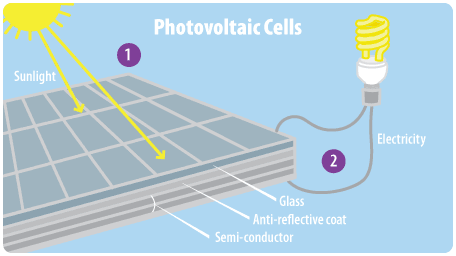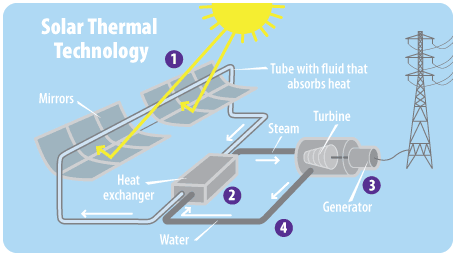Solar Energy

Why is daytime brighter and warmer than nighttime? The answer is simple: solar energy. Solar energy is simply the light and heat that come from the sun.
People can harness the sun's energy in a few different ways:
- Photovoltaic cells, which convert sunlight into electricity.
- Solar thermal technology, where heat from the sun is used to make hot water or steam.
- Passive solar heating, which can be as simple as letting the sun shine through windows to heat the inside of a building.
Photovoltaic Cells
Do you have a solar calculator or watch? These items are powered by photovoltaic cells. A photovoltaic cell absorbs light and converts it directly into electricity. A group of photovoltaic cells is known as a solar panel.
You may have seen solar panels on houses, on electronic road signs, or in parking lots to power lights. People who have solar panels on their homes buy less electricity from their utility companies because they're producing some electricity on their own. If you have enough solar panels, you might even be able to generate more power than you need. In some states, this means you can run your electric meter backwards and give your extra electricity to the rest of the community. The electric company ends up paying you!
How It Works

- Sunlight hits the surface of the photovoltaic cell.
- A material called a semi-conductor converts the light into electricity.
Watch a video to learn more about how photovoltaic cells work.![]()
Solar Thermal Technology
Another way to tap solar energy is by collecting the sun's heat. Solar thermal power plants use heat from the sun to create steam, which can then be used to make electricity. On a smaller scale, solar panels that harness thermal energy can be used for heating water in homes, other buildings, and swimming pools.
How It Works

- Mirrors or reflectors concentrate the sun's rays to heat a special kind of liquid.
- The heat from this liquid boils water to create steam.
- Steam spins a turbine that is connected to a generator, which creates electricity.
- The steam cools and condenses back to water, which is recycled, reheated, and converted into steam again.
Passive Solar Heating
Have you ever noticed how sunlight streaming through a window can make your home feel warmer, even on a cold day? If so, you've seen passive solar heating in action! People can design or remodel buildings to take advantage of heat from the sun during the winter. It helps to have large windows that face south (the side that gets the most sunlight everywhere north of the Equator) and are not shaded by other buildings or trees. A good design often includes overhangs, movable awnings, or blinds that block the sun during the summer when people need to cool their homes instead of heating them.
Cool Facts
- Solar–powered school buses. A town in Wisconsin is using solar panels to charge hybrid electric school buses.
- Google maps for solar panels. If you live in San Francisco
 or Boston
or Boston , you can see the solar panels in your neighborhood on a map.
, you can see the solar panels in your neighborhood on a map. - How cool is this? In 2010, China unveiled the first solar-powered air conditioner. If mass–produced, these devices could help reduce energy use and greenhouse gas emissions in China and other countries.
- Solar joins the major leagues. Taiwan's National Stadium is being touted as the world's largest sports stadium. It's nicknamed the “flying dragon” after its silver–blue canopy, which coils like a tail and contains nearly 9,000 solar panels. When it's not in use, the stadium powers homes and businesses.